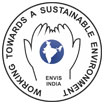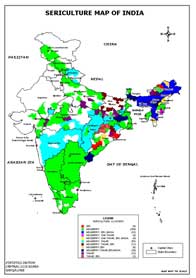Sericulture DirectorateThe Sericulture Directorate is responsible for development of Sericulture in Sikkim. Till the end of the Eighth Five Year Plan, the activities of sericulture were at low profile but has picked up pace from the beginning of the Ninth Five Year Plan. The state government has approved the project for Rs. 5.00 crore for “Development and Extension of Sericulture in Sikkim” in the Ninth Five Year Plan. Although the activities are currently confined to the three districts viz. East, South and West, suitable areas of North District are also being taken in the various stages of the project. 115 villages and 1300 families have been earmarked to be covered during the project period of five years. The Central Board has also agreed to provide financial assistance for training of sericulture farmers and for infrastructure development of the project. The directorate is maintaining three Sericulture farms, one each in East, South and West District. The main objectives of the Sericulture Directorate are:
It has been a joint venture between state government and Central Silk Board to make the sericulture practices flourish in this non-traditional zone of Sikkim State. In this regard continuous efforts are being made by the Board also through the Regional Extension Centre situate at Rangpo. Various programmes are being launched like TAR, despite of financial assistance on subsidy to the farmers and up-gradation of Govt. establishments under the CDP. And in spite of every efforts from the govt. participating people are found quite irresponsive also, which could also be overcome in the near future for making this scheme a great success in the regions like Sikkim State. State Plan and Programme (Allocation and Expenditure over the Plan.)
All three types of sericulture has ample scope for its growth in this region, desperately requires serious thought in exercising technology and financial input. Financial input is not only the factor for its promotion, however technology, manpower and infrastructure plays equal role in the process of development [Top]Beneficiaries Adopted for Sericulture Development in Sikkim
[Top] Silk Industry [Top] Eri Sector: In the state of Sikkim natural distribution of Eri food plants viz. Castor abundantly available, and Tapioca is also cultivated by every farmers for consumption of its root, one more perennial host plant called Khanakpa in local language is also available. Hence, in consideration to its best utility of leaves and seed of castor for economic boost up of our poor farmers, Ericulture has been introduced first time in the year 2003-04, in some of the villages as indicated below: Area and Production Statue:
Muga Sector: Augmentation of Muga food plants was introduced in 2003-04 in Sikkim, under the CDP, identified host plant called Kutmero in local language (Litsea polyantha) abundantly available in natural conditions needs only systematic plantation. In the same year nearly 12 acres has been brought under muga host plant plantations in South and West Sikkim. This may be seen under the tab given below:
Marketing Actual problem being faced by the state is marketing of cocoons, out the four crops only last crop harvested in the month of October had been disposed off to the private granures as Seed cocoon, that too is at very low price. However, there is chances of better co-ordination between the two states of Sikkim and West Bengal in marketing the all three types of cocoons produced in this state, which shall be operated symbiotically in near future. [Top]Infrastructure Infrastructures required for the Sericulture industry in the state is very limited, as per the area and volume of activities even though, minimum required facilities have been arranged in the Govt. sectors. However, private entrepreneurs in the sericulture sector is yet to come.
Employment Out of the 370 families those have taken up mulberry plantations in their own land, vary few of them are continuing it as part time work and majority of the farmers have started neglecting since they could not gain confidence out of it due to (i) Higher mortality of plantations (ii) Regular failure in rearing (iii) Less remuneration or lack of marketing and (iv) and other reasons. The villagers doing part time sericulture in the state is given in subsequent page:
|
|||||||||||||||||||||||||||||||||||||||||||||||||||||||||||||||||||||||||||||||||||||||||||||||||||||||||||||||||||||||||||||||||||||||||||||||||||||||||||||||||||||||||||||||||||||||||||||||||||||||||||||||||||||||||||||||||||||||||||||||||||||||||||||||||||||||
FORESTS, ENVIRONMENT & WILDLIFE MANAGEMENT DEPARTMENT Government of Sikkim
ENVIRONMENT Quick Links: SoE Report |
Pollution |
Status & Issues |
EIA/EMP |
SEIAA/SEAC |
Clearances |
Public Notice |
NEAC |
NGC |
...More
BIODIVERSITY Quick Links: Flora & Fuana |
State Biodiversity Board |
State Biodiversity Rules |
State Biodiversity Action Plan |
Medicinal Plants & NTFP |
IBAs |
Bamboo Species | ...More
WILDLIFE Quick Links: Protected Areas |
Himal Rakshaks |
Conservation Zones |
Prespective Management Strategies |
...More
FOREST & FORESTRY Quick Links: Forest Types of Sikkim |
Forest Management |
Forest Statistics | ...More
LAND & WATER Quick Links: Wetlands |
Wastelands |
Treatment of Landslides & Soil Erosion Control |
Pokhri Sangrakshan Samiti |
...More
ECOTOURISM Quick Links: White Paper on Ecotourim Policy |
Sikkim Trekking Regulation |
Ecotourism Destinations |
Sacred Natural Sites | ...More
SERICULTURE Quick Links: Sericulture Directorate |
Beneficiaries |
Silk Industry |
Eri & Muga Sectors |
Marketing, Infrastructure & Employment


